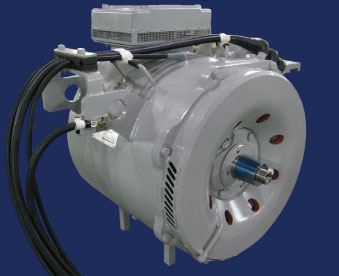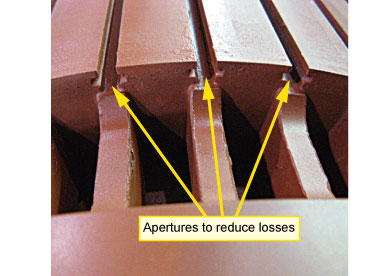1. High efficiency induction traction motor
- A high efficiency induction traction motor was developed, with a view to improving the energy saving performance of railway vehicles.
- 96% efficiency was achieved employing low loss material and a new rotor design.
- The new induction traction motor managed to cut electrical energy consumption by approximately 10%.
In typical commuter trains on conventional lines, a large share of electrical energy consumption is due to traction motor losses. In order to cut these energy losses therefore, a new low loss traction motor was developed.
In order to ensure that the new model motor could be easily interchanged with the old type, it was modeled on the basic structure and shape of the existing self-ventilated traction motor.
In order to improve efficiency, low loss material was used for the conductors through which electricity flows and the iron core through which the magnetic flux flows, and the reduction in loss was measured. The electric loading and magnetic loading were then shifted to find their optimal distribution, and again reduction in loss was measured. Computer simulation was then applied and revealed that part of the loss occurred on the rotor conductor surface. The rotor shape was therefore reconsidered, and a new design was proposed, to reduce the loss. The new design helped reduce loses by introducing apertures close to the areas on the surface of the rotor where losses had been found to be concentrated.
The results of test on a prototype traction motor built according the findings described above proved to raise efficiency to around 96%. This was a significant improvement compared to existing traction motors which only had an efficiency of around 93%.
Running simulations were made to estimate potential energy savings in actual operation. These showed that compared to previous traction motors, a maximum energy saving of approximate 10% could be achieved.
This research was conducted with funding from the Ministry of Land, Infrastructure, Transport and Tourism.

Fig.1 The prototype traction motor
Fig.2 The new rotor design